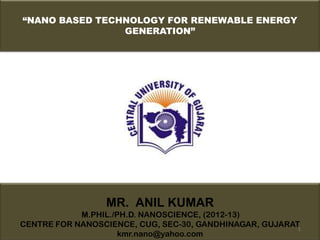
Nano-Based Solar Cells for Renewable Energy
- 1. “NANO BASED TECHNOLOGY FOR RENEWABLE ENERGY GENERATION” MR. ANIL KUMAR M.PHIL./PH.D. NANOSCIENCE, (2012-13) CENTRE FOR NANOSCIENCE, CUG, SEC-30, GANDHINAGAR, GUJARAT1 kmr.nano@yahoo.com
- 2. Contents Introduction of Renewable Energy Solar Electric Power Plants What is a Photovoltaic Cell How PV Cells Work Dye-Sensitized and Silicon-based Solar Cells Compared Dye-Sensitized Solar Cells So What Does this Mean for Solar Cells Absorption of Light by Ionic Compounds Absorption of Light by Atoms But Not All Energy is Converted Application of Energy Natural Forming sources of Energy, Application and effects Renewable sources of Energy, 2 Application and effects
- 3. Introduction of Renewable Energy Nanotechnologies have significant potential to assist economies in meeting their energy efficiency goals, enabling adoption of new approaches, techniques and materials with a wide range of applications, from efficient usage of traditional energy sources to development and implementation of new generation technologies based on renewable sources. The nanotechnology impact is especially important for renewable energy, which together with energy efficiency are pillars of sustainable energy policy. 3
- 4. Solar Electric Power Plants • Main types: 1. Solar thermal energy • Has mirrored surface that reflects sunlight Array of mirrored solar collectors at to heat up liquid to FPL Energy site in California make steam to generate electricity 2. Photovoltaic • Uses photovoltaic cells that absorb direct sunlight Concentrated solar collector (parabolic) 4 Sources: http://en.wikipedia.org/wiki/Solar_energ , http://www.fplenergy.com/portfolio/solar/facts.shtml#glance
- 5. What is a Photovoltaic Cell? • Is a device of generating electrical power by converting solar radiation into direct current electricity using semiconductors that exhibit the photovoltaic effect. • Photovoltaic power generation employs solar panels composed of a number of solar cells containing a photovoltaic material. • Materials presently used for photovoltaics include monocrystalline silicon, polycrystalline silicon, amorphous silicon, cadmium telluride, and copper indium gallium selenide or sulfide….. etc. How PV Cells Work? 1. Photons in sunlight hit the solar panel and are absorbed by semiconducting materials, such as silicon. 2. Electrons (negatively charged) are knocked loose from their atoms, allowing them to flow through the material to produce electricity. 3. An array of solar cells converts solar energy into a usable amount of direct current (DC) electricity. 5
- 6. Dye-Sensitized and Silicon-based Solar Cells Compared • Dye-Sensitized “Nano” • Traditional “Single-crystal silicon” 1. Relatively 1. Expensive inexpensive 2. Long return 2. Short return on on investment investment 6 Sources: http://www.imo.uhasselt.be/polytech/images/zonnecel1.jpg, http://www.norfolksolar.co.uk/img/system.gif
- 7. Dye-Sensitized(“nano”) Solar Cells • Relatively inexpensive 1. Made in non-vacuum setting mainly at room temperature 2. Relatively simple manufacturing process • Need little TLC 1. Thin, lightweight, flexible • Short return on investment 1. Takes approx 3 months to produce energy savings equivalent to cost of production 7 Source: http://www.imo.uhasselt.be/polytech/images/zonnecel1.jpg
- 8. So What Does this Mean for Solar Cells? • In dye-sensitized solar cells… – Talk about highest occupied molecular orbital (HOMO) and lowest unoccupied molecular orbital (LUMO) • In single-crystal silicon solar cells… – Talk about “conduction band” (excited states) and “valence band” (ground states) 8
- 9. Absorption of Light by Ionic Compounds • Electrons can jump between “bands” • Incident light with energy ≥ than the “band gap” energy can be used to excite the electrons 9 Source: Image adapted from http://www.3dchem.com/molecules.asp?ID=135#
- 10. Absorption of Light by Atoms • Absorption occurs only when the energy of the light equals the energy of transition of an electron Single electron transition in an isolated atom 10 Sources: http://members.aol.com/WSRNet/tut/absorbu.htm, http://csep10.phys.utk.edu/astr162/lect/light/absorption.html
- 11. But Not All Energy is Converted • Like chloroplasts in plants, solar cells can only absorb specific wavelengths of light. • In both, light that isn’t absorbed is either transmitted through or reflected back. • Whether a certain wavelength of lights gets absorbed depends on its energy. Chlorophyll molecules absorb blue and red light, but reflect green light 11 Source: http://ebiomedia.com/prod/cyclops/images/image004.jpg
- 12. Application of Energy Natural form for sources of Energy Hydro-Carbon Nuclear Power Hydro Power Alternative Energy Nanotechnology Approaches for Renewable Energy Generataion Solar Energy Wind Energy Geothermal steam Biomass 12
- 13. Natural Forming sources of Energy, Application and effects We know that, our main energy sources for human Flow chart of Energy sources activity are fossil and mineral fuels, nuclear and hydroelectric sources. They are very harmful to environment because they cause global warning, ozone layer depletion, biosphere and geosphere destruction, and ecological devastation. Around 80 wt% of CO2 emissions in the world are originated by the energy sector Changes towards environmental improvements are becoming more politically acceptable globally, especially in developed countries. Society is slowly moving towards seeking more sustainable production methods, waste minimization, reduced air pollution from vehicles, distributed energy generation, conservation of native forests, and reduction of greenhouse gas emissions. 13 Source Figure: Elena Serrano, et al. 2009
- 14. Renewable sources of Energy, Application and effects Flow chart of Renewable Energy sources Nanotechnology is generating a lot of attention these days and therefore building great expectations in renewable energy challenges with nano-sciences in 21th century, the governments, and industry. For renewable energy are solar, hydrogen and new generation batteries and supercapacitors are described as the most significant examples of the contributions of nanotechnology in the energy Source Figure: Elena Serrano, et al. 2009 sector. 14
- 15. THANKING YOU FOR A KIND ATTENTION……. 15 Source Figure : Elena Serrano, et al. 2009